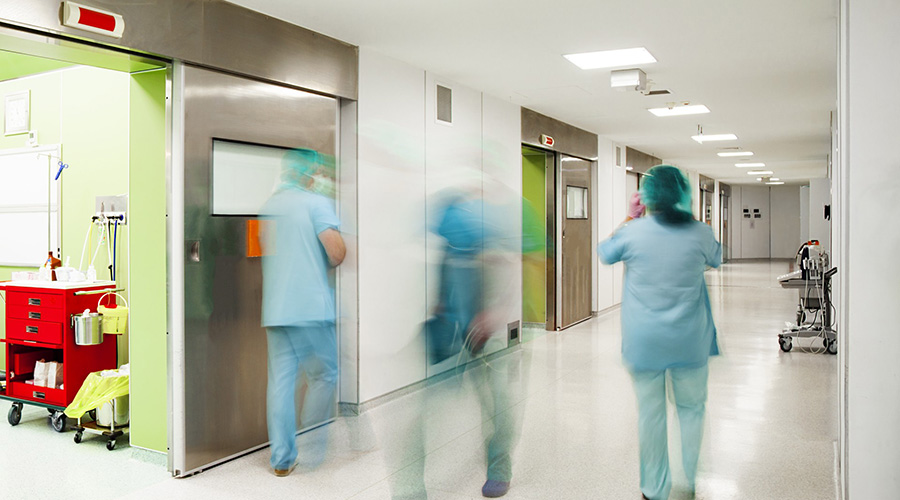Cleaning bedpans with commode spray arms or soiled utility sinks is, at best, an unsavory experience. But more importantly, it is also a high-stakes art form that is performed countless times a day, each time potentially creating a hazard for employees, patients and even visitors.
Ask any caregiver about current methods for bedpan cleaning and he or she will confirm that one wrong move or slip of the hand results in needing to change your scrubs or worse, a visit to the employee health office.
Even the most seasoned healthcare professional can experience splash back and overspray with spray arms and utility sinks. And regardless of technique, the high pressure of these tools can lead to aerosolization of microbes in the waste being cleaned, a contamination that is impossible to avoid and detect.
It truly is a matter of when a caregiver will be contaminated, not if. And when a caregiver is contaminated, that risk is then shared with the patients for whom he or she is responsible
This high level of exposure risk posed to healthcare professionals and patients should not come as a surprise. With the advances in virtually every other practice in the healthcare industry, one would assume such antiquated methods for bedpan waste disposal would be behind us. Unfortunately, these procedures have not changed in more than two generations in the United States.
A modern solution
With the exception of the U.S., most industrialized nations now use mechanized bedpan washing technologies today. These tools are most simply described as hospital-grade dishwashers for bedpans.
Commonly known as “healthcare disinfection appliances” or just “bedpan washers,” these machines are — for good reason — the standard in international acute care hospitals, long-term care facilities and other facilities in which bedpans are frequently used.
Caregivers open the door of a bedpan washer using a touch-free sensor or hands-free kick plate, and insert the soiled bed pan. When the door is sealed, a telescopic rotary jet and auxiliary nozzles flush the bedpan contents and provide complete disinfection at 187 degrees—a temperature caregivers’ hands could never tolerate.
At the end of the cycle, bedpans are cooled to make them ready for immediate reuse. Some manufacturers cool bedpans with water though others opt for air cooling, which also dries the bedpans and the interior of the machine, further reducing opportunities for organisms to breed and spread.
For everyone who is remotely familiar with current methods, even this short description of bedpan washers makes clear the multitude of improvements these machines bring.
Time and grief
Much like an accidental needle stick, when exposure accidents happen as a result of spray arms and soiled utility sinks, it creates strain for the caregiver and patient as well as the facility in which it occurs.
The caregiver must immediately report to employee health, potentially take a regimen of prophylaxis and endure baseline tests and tests for infections. The patient also is tested for infections while the facility foots the bill for all of the extra medications, tests, time and resources. Over the long-term, the facility also pays for compromised productivity because contamination scares can lead to lasting trepidation among caregivers.
By implementing bedpan washers, healthcare facilities help reduce this daily risk of the time and expense of bedpan washing-related contaminations and reap the benefit of a more productive workforce.
Single disposal process
Most bedpan washers are capable of performing many tasks beyond bedpan washing. Because different institutions handle different waste from different patients in different ways, there is considerable need to simplify the waste disposal process overall, saving time and accidental breaches of complex procedures.
Most bedpan washer manufacturers offer a variety of racks that can be placed in a single machine. These racks can hold everything from urine bottles to suction containers to bedside commodes. Some racks even feature a slicing mechanism for full catheter bags; after the machine closes, a blade opens the bag and drains it completely. By washing items like these before disposal, they can now be put in regular waste as opposed to red bag waste, the cost of which is considerable and climbing every year.
HAIs and ROI
But containing splash back is only part of the story. The current uptick of healthcare associated infections (HAIs) like C. diff. and CRE has many facilities also seeing increased readmission rates—some by as much as 40 percent—and loss of life.
The American healthcare system is already tightly squeezed financially and reimbursements will continue to decrease in relation to readmission rates per the Affordable Care Act. In order to ensure the long-term safety of patients—which can only occur within a financially secure healthcare facility—hospital executives, purchasing agents as well as infection control and prevention professionals are looking at a new landscape when it comes to what works and what doesn’t for patient safety and the bottom line.
Since so many HAIs are transmittable through human waste and because many of those organisms can live on surfaces for days, there is a “race to zero” in which bedpan washers can make a significant difference because of their ability to both contain and eliminate contaminates.
Intelligent implementation
Bedpan washers come in several configurations for easy installation and so they can fit into the best suitable location for daily operation. Counter-height and freestanding vertical configurations are specifically designed to slide into existing soiled utility rooms for simple implementation. Some manufacturers offer units created to be flush wall-mounted. These are intended to be built into individual patient rooms in order to make the path of possible contamination even shorter.
In U.S. hospitals that have embraced this technology, many have opted to install these flush-mounted machines in ICU/CCU rooms where almost all waste is handled by bedpans due to the patient’s non-ambulatory state.
As more is demanded of caregivers and standards for healthcare providers increase, the need to identify and implement systems that address multiple concerns will be important. And because during this same time budgets also will be stretched, finding solutions that have a proven impact will be vital. Importing the practice of utilizing bedpan washers is both tried-and-true and provides multifaceted gains, from the nurse’s station to the CFO’s office.
Rodriguez is manager of healthcare equipment sales at MEIKO, a manufacturer of commercial washing equipment.

 Making the Energy Efficiency Case to the C-Suite
Making the Energy Efficiency Case to the C-Suite How to Avoid HAIs This Flu Season
How to Avoid HAIs This Flu Season Design Phase Set to Begin for Hospital Annex at SUNY Upstate Medical
Design Phase Set to Begin for Hospital Annex at SUNY Upstate Medical Building Hospital Resilience in an Era of Extreme Weather
Building Hospital Resilience in an Era of Extreme Weather Ennoble Care Falls Victim to Data Breach
Ennoble Care Falls Victim to Data Breach